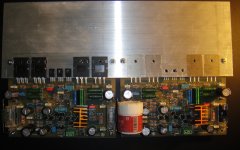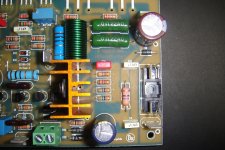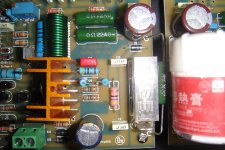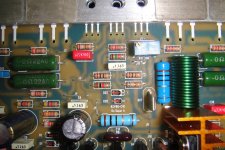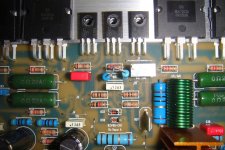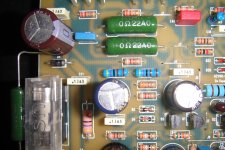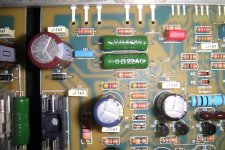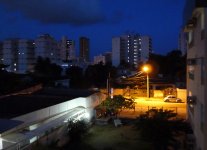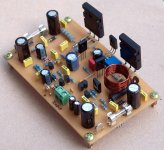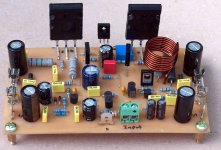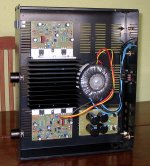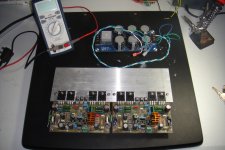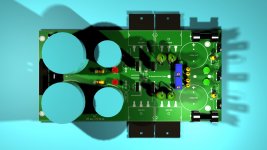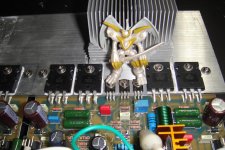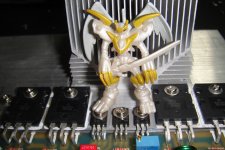I have made the drill today, and it was not easy to keep alignment so I did the best I can, I have found a bottle of "chingiling" thermal white paste just enough to apply to the heat sink insulators, maybe today I might be able to bias it, if all goes smoothly , also I have to replace those resistors with the correct size one now that I have them on hand, and yes mister Carlos, I still have that Toshiba from my friend he didn't pick up up yet, but is a vintage amplifier, but it can not get even close to Dx Super A sound quality, and Super A has even more power than the Toshiba SC-665, sorry that is my opinion,  oh sorry again damn! , about the resistors here are the images so you know what I mean about replace those blue color resistor for the brown ones.
oh sorry again damn! , about the resistors here are the images so you know what I mean about replace those blue color resistor for the brown ones.
Regard
Juan
Regard
Juan
Attachments
Last edited:
That’s lovely stuff Juan looking very good, hopefully next month I can taste how delicious the Stereo of Super A, But I will just use 1943/5200 these are the available power transistor in my place, hope I can get the same power in 4 Ohms.
Regards,
Willy
Hey my man!
hey bro, make sure that all jumpers are in place double... triple ...check all and make sure the trim pot is on the highest resistance about 190 ohms power supply about 43V apply power and slowly begin to adjust until close to 2V then wait, for thermal heat sink to stabilize, then get it where you see about 2.48V is 2.5V but for now wait 5 minutes, then wait even more about 15 to 20 minutes... then you can adjust till you get about 2.5V maybe not all multimeter work the same so yeah about 2.5V or close. that is the way I did it maybe you are more advance than me so it will be easy for you. just to add a quick note: " this is the way I did".
Regards
Juan
Hey my man!
hey bro, make sure that all jumpers are in place double... triple ...check all and make sure the trim pot is on the highest resistance about 190 ohms power supply about 43V apply power and slowly begin to adjust until close to 2V then wait, for thermal heat sink to stabilize, then get it where you see about 2.48V is 2.5V but for now wait 5 minutes, then wait even more about 15 to 20 minutes... then you can adjust till you get about 2.5V maybe not all multimeter work the same so yeah about 2.5V or close. that is the way I did it maybe you are more advance than me so it will be easy for you. just to add a quick note: " this is the way I did".
Regards
Juan
Thank you very much bro, these information is very valuable for me, I will follow these steps and let you know the outcome, but the only concern I have right now is the multi turn trimmer, this particular trimmer is not available locally that’s why I want to ask uncle Charlie about the layout file, this way I can customize the parts I have on hand otherwise very difficult bro.
Uncle Charlie I need the layout file of these Super A please……… Thanks in advance for your help…
Regards,
It is late here..... i want you to know that Zeraphine assembled the Dx Super A
Also i have made a video showing the supply pcboard prepare:
Preparing Dx Supply pcboards at home - YouTube
regards,
Carlos
Also i have made a video showing the supply pcboard prepare:
Preparing Dx Supply pcboards at home - YouTube
regards,
Carlos
Attachments
This enclosure have Dx Blame ST already modified to Super A
But these boards will be removed, a Dx supply will be inside (stabilized) and two Dx Super A pcboards will be in place too.
I am just waiting my boards to arrive to make it.
I will also receive dual coil super speakers... will be a paradise this home!
By Lira - speakers to the Dx Corporation - YouTube
Dx Symetrical, stabilized and adjustable power supply - YouTube
Here you have the Dx Supply thread...was moved, i made a mistake to post it separated and moderator sent the thread to the Supply thread...my mistake, this is a Dx Super A accessory, works together and should be inside this same thread....not it is too late..here you have the link:
http://www.diyaudio.com/forums/powe...utput-adjustable-stabilized-power-supply.html
regards,
Carlos
But these boards will be removed, a Dx supply will be inside (stabilized) and two Dx Super A pcboards will be in place too.
I am just waiting my boards to arrive to make it.
I will also receive dual coil super speakers... will be a paradise this home!
By Lira - speakers to the Dx Corporation - YouTube
Dx Symetrical, stabilized and adjustable power supply - YouTube
Here you have the Dx Supply thread...was moved, i made a mistake to post it separated and moderator sent the thread to the Supply thread...my mistake, this is a Dx Super A accessory, works together and should be inside this same thread....not it is too late..here you have the link:
http://www.diyaudio.com/forums/powe...utput-adjustable-stabilized-power-supply.html
regards,
Carlos
Attachments
Last edited:
Try the Dx Supply after you finish the adjustments.
before you install inside the enclosure.... i do have strong suspections you will love the regulator and will prefere it compared with your supply.... the sound result you can feel....bass is more pure, has no noise from the mains mixed with low tone bass.
When you drain huge current (4 ohms and full power as an example), then noises from the mains will appear into your positive and negative supply lines... this noises will go together your audio...so, your low frequency will be mixed with 60 hertz from the mains...will not be pure.... when you beat two tones..let's say 30 hertz together 60 hertz, you gonna have 30 hertz into your speaker, also you gonna have small volume of 60 hertz... even a smaller volume of 90 hertz and harmonics of these tones too... a big mess...this happens full power only.... a dirt bass tone.
It would happens with mids and treble too if these tones where not so small compared to the bass tones that represents almost 60 percent of the entire musical spectrum...so...bass will suffer...mids and highs maybe not
You are someone that loves bass...so...make it pure to your ears..... assemble the Dx Supply and put it into work for you..... you can use any series pass regulator that uses capacitance multiplier..not only Dx Supply, there are many models available...use one of them.
You do not need special transformers...you can use the voltage available.... just adjust the supply to a maximum of 4 volts less the transformer voltage without load... the voltage is not important..what is important is the transformer power.... and even this subject you can control using 8 ohms instead of 6 ohms, instead of 4 ohms and instead of 2 ohms.
Believe in your friend... results much better...if you have doubts i can make a video with and without the regulator and you will listen the mess when we drain full power from the supply/amplifier.
In your case...maybe not that noise..because you are using an expensive and huge bank of electrolitic capacitors..but this is (was) expensive.... these capacitor you have are enougth for you to assemble 3 Dx Supply regulators, to feed 3 stereo power amplifiers..naturally you will need transistors too... maybe the cost will not reduce..but for sure the performance gonna be better.
If you do not intend to use full power... pumping bass into your speakers till your windows shake..then you will not need such kind of supply...but i really doubt you will not cranck the volume all the way up.
regards,
Carlos
before you install inside the enclosure.... i do have strong suspections you will love the regulator and will prefere it compared with your supply.... the sound result you can feel....bass is more pure, has no noise from the mains mixed with low tone bass.
When you drain huge current (4 ohms and full power as an example), then noises from the mains will appear into your positive and negative supply lines... this noises will go together your audio...so, your low frequency will be mixed with 60 hertz from the mains...will not be pure.... when you beat two tones..let's say 30 hertz together 60 hertz, you gonna have 30 hertz into your speaker, also you gonna have small volume of 60 hertz... even a smaller volume of 90 hertz and harmonics of these tones too... a big mess...this happens full power only.... a dirt bass tone.
It would happens with mids and treble too if these tones where not so small compared to the bass tones that represents almost 60 percent of the entire musical spectrum...so...bass will suffer...mids and highs maybe not
You are someone that loves bass...so...make it pure to your ears..... assemble the Dx Supply and put it into work for you..... you can use any series pass regulator that uses capacitance multiplier..not only Dx Supply, there are many models available...use one of them.
You do not need special transformers...you can use the voltage available.... just adjust the supply to a maximum of 4 volts less the transformer voltage without load... the voltage is not important..what is important is the transformer power.... and even this subject you can control using 8 ohms instead of 6 ohms, instead of 4 ohms and instead of 2 ohms.
Believe in your friend... results much better...if you have doubts i can make a video with and without the regulator and you will listen the mess when we drain full power from the supply/amplifier.
In your case...maybe not that noise..because you are using an expensive and huge bank of electrolitic capacitors..but this is (was) expensive.... these capacitor you have are enougth for you to assemble 3 Dx Supply regulators, to feed 3 stereo power amplifiers..naturally you will need transistors too... maybe the cost will not reduce..but for sure the performance gonna be better.
If you do not intend to use full power... pumping bass into your speakers till your windows shake..then you will not need such kind of supply...but i really doubt you will not cranck the volume all the way up.
regards,
Carlos
Attachments
Last edited:
Yesterday I completed the other board, now I have to adjust the bias today and soon I will have stereo. looks really nice.
Regards
Juan
Great job Juan!!! Congrats.....



Please elaborate further the Stereo Super A.
Uncle Charlie is this Regulated PSU intended for Stereo? i mean if the transformer capacity is 52VACx2/1200VA?
regards,
Last edited:
WilJJ78, your case is a little bit complicated.
I will post the answer here and also will post this stuff in the Dx Supply thread that was moved (sadly because it is to be used together this amplifier)...i have made a mistake....the good idea was to publish inside this same thread because it is an accessorie to the Dx Super A.
Dx Supply was made for our friends to save money because electrolitic condensers are very expensive.... It also provides yout stable output voltage and this helps you to achieve the low levels of distortion published.
It was made to receive maximum of 60 plus 60 volts DC and this comes from a 42 plus 42 volts alternated transformer... the maximum power to be drained, under these voltages, is 180 plus 180 watts, and this represents 360 total watts.
So, it was made for you to adjust 42 plus 42 volts into the output...this is the correct voltage to feed the Dx Super A amplifier.
Observe Dx Super A power specifications (42 plus 42 volts), results from the simulator with the supply voltage stable (regulated, stabilized at 42+42)
- 85 Watts RMS at 8 ohms, THD 0.001%, 1.5A plus 1.5A of current drain, that represents a power consumption of 63 watts plus 63 watts (63 watts per rail) and the total of 126W (efficiency is around 67% to 8 ohms).... rail fuses should be slow blow, 1.5A plus 1.5A or a little bit more if you like to enter clipping... speaker series fuse is 3A or a little bit more if you intend to enter clipping.
- 160 Watts RMS at 4 ohms, THD 0.002%, with 3A plus 3A of current drain, that represents a power consumption of 126 + 126W, or total of 254W... rails fuses should be 3A or more, all them slow blow... speaker fuse 6A or more...also slow blow.
- 250 Watts RMS at 2 ohms, THD 0.005%, with 5A + 5A of current drain, that represents a power consumption of 210 + 210W, or a total of 420 Watts of total power consumption.... 5A plus 5A slow blow fuses to the rails and 10A series fuse in series with the speakers (slow blow)
But, if you accept some distortion (we all accept..if we do not accept, the amplifier clips anyway and sometimes we do not perceive so fast it is)...then it can go to:
290 Watts RMS - 2 ohms - 1 percent distortion
330 Watts RMS - 2 ohms - 5 percent distortion
360 Watts RMS - 2 ohms - 10 percent distortion
10% distortion is not that crazy as you think, because some manufacturers (respectable ones) publish integrated circuit distortion at this level of distortion to increase the numbers...watch manufacturer datasheedt about them.
360 Watts RMS is the worst case scenario.... where the supply will face the maximum consumption resulted from the Dx Super A operation at 2 ohms and with 10 percent of distortion... here the current drain goes to 6.3A each rail ... and the consumption is 530 watts to a single channel.
The Dx Supply is good to feed two channels operating simultaneously, at 8 ohms and full power.
The Dx Supply can to feed one channel if you operate at 4 ohms, so, under this sittuation you will need two supplies, one to each channel.
The Dx Supply will need an extra pair of transistors to operate safe if you feed one channel at 2 ohms and drive it to full power (distorted)... you should check your rectifier rating and electrolitic condenser values because the supply was made, mainly, to feed two channels at 8 ohms.... two pair of transistors was the choice to save money into this supply.... so... you gonna need to tweak if you decide to push the limits into 2 ohms loads.... one of the main need is the extra pair of series power transistor...so... as a result, you gonna have three ouput pairs.
To be continued.....
regards,
Carlos
I will post the answer here and also will post this stuff in the Dx Supply thread that was moved (sadly because it is to be used together this amplifier)...i have made a mistake....the good idea was to publish inside this same thread because it is an accessorie to the Dx Super A.
Dx Supply was made for our friends to save money because electrolitic condensers are very expensive.... It also provides yout stable output voltage and this helps you to achieve the low levels of distortion published.
It was made to receive maximum of 60 plus 60 volts DC and this comes from a 42 plus 42 volts alternated transformer... the maximum power to be drained, under these voltages, is 180 plus 180 watts, and this represents 360 total watts.
So, it was made for you to adjust 42 plus 42 volts into the output...this is the correct voltage to feed the Dx Super A amplifier.
Observe Dx Super A power specifications (42 plus 42 volts), results from the simulator with the supply voltage stable (regulated, stabilized at 42+42)
- 85 Watts RMS at 8 ohms, THD 0.001%, 1.5A plus 1.5A of current drain, that represents a power consumption of 63 watts plus 63 watts (63 watts per rail) and the total of 126W (efficiency is around 67% to 8 ohms).... rail fuses should be slow blow, 1.5A plus 1.5A or a little bit more if you like to enter clipping... speaker series fuse is 3A or a little bit more if you intend to enter clipping.
- 160 Watts RMS at 4 ohms, THD 0.002%, with 3A plus 3A of current drain, that represents a power consumption of 126 + 126W, or total of 254W... rails fuses should be 3A or more, all them slow blow... speaker fuse 6A or more...also slow blow.
- 250 Watts RMS at 2 ohms, THD 0.005%, with 5A + 5A of current drain, that represents a power consumption of 210 + 210W, or a total of 420 Watts of total power consumption.... 5A plus 5A slow blow fuses to the rails and 10A series fuse in series with the speakers (slow blow)
But, if you accept some distortion (we all accept..if we do not accept, the amplifier clips anyway and sometimes we do not perceive so fast it is)...then it can go to:
290 Watts RMS - 2 ohms - 1 percent distortion
330 Watts RMS - 2 ohms - 5 percent distortion
360 Watts RMS - 2 ohms - 10 percent distortion
10% distortion is not that crazy as you think, because some manufacturers (respectable ones) publish integrated circuit distortion at this level of distortion to increase the numbers...watch manufacturer datasheedt about them.
360 Watts RMS is the worst case scenario.... where the supply will face the maximum consumption resulted from the Dx Super A operation at 2 ohms and with 10 percent of distortion... here the current drain goes to 6.3A each rail ... and the consumption is 530 watts to a single channel.
The Dx Supply is good to feed two channels operating simultaneously, at 8 ohms and full power.
The Dx Supply can to feed one channel if you operate at 4 ohms, so, under this sittuation you will need two supplies, one to each channel.
The Dx Supply will need an extra pair of transistors to operate safe if you feed one channel at 2 ohms and drive it to full power (distorted)... you should check your rectifier rating and electrolitic condenser values because the supply was made, mainly, to feed two channels at 8 ohms.... two pair of transistors was the choice to save money into this supply.... so... you gonna need to tweak if you decide to push the limits into 2 ohms loads.... one of the main need is the extra pair of series power transistor...so... as a result, you gonna have three ouput pairs.
To be continued.....
regards,
Carlos
The dissipation into these series pass transistors
The ones are in the Dx Supply, made to be used together the Dx Super A audio power amplifier.
We gonna have, as the worst case scenario, (when transformer have no voltage... but this is almost impossible....but for safety reasons we take this into our calculations) a voltage drop of 18 volts (60 to 42C) into the series pass transistors, so, multiply this voltage drop by the rail current (that gonna depend your case/choice)... then you will have the power developed into the series pass transistor colector to emitter junctions (input to output of the series pass regulator transistors)
As an example, to clarify the subject, if you have TWO Dx Super A channels, driving 8 ohms loads, operating full power (undistorted), draining energy from a single Dx Supply, will result in 54 plus 54 Watts of power dissipation.... in real world this use to be much less, because we have voltage drop into the Dx Supply input, so, voltage drop from colector to emitter being reduces will reduce the result of the multiplication of current by the voltage that results in the power.
My Dear WilJJ78, your case is a little bit complicated, as you want to enter a higher voltage into the Dx Supply input....much higher than we have calculated.
52 Volts AC means aprox. 73 Volts DC, so, your voltage drop into the series pass transistors (adjusting 42 volts at the regulator output) will be 31 Volts, so, i strongly suggest you , dear Bahrain, to build two Dx Supplies feeding your stereo with two separated power supplies, one to each channel... and each one of your channels will need three output pairs, so, you will have to install an extra pair the way you can...also rectifier must be checked, it must be minimum of 15A, also the first condensers, the main filters after rectification should be reinforced..you have to prepare extra boards to put more units in parallel with the ones are in the Dx Supply board...all this special because you case is special.... your dissipation power into the series pass transistors may reach 200 Watts each rail and this is huge..and all that stuff is due to the higher input voltage you will use...this is what will create all troubles....you gonna be using 10AC volts more...this increases the load into the series pass transistors a lot!
Another option is never use 2 ohms..then you can try the standard Supply with 4 ohms loads...but use two supplies....if you decide to use 8 ohms only..then a single supply will be good enough.
In all cases, your power dissipation into the supply series pass transistor will be huge.... the difference in between the input voltage (73) and the output adjusted voltage (42) is too much big... and you cannot increase the supply voltage because it is already in the limit to the power amplifier to operate at 2 ohms...so... cannot increase to reduce your heat.
I do Think your transformer is no good...too much high voltage...will create troubles to us.
regards,
Carlos
The ones are in the Dx Supply, made to be used together the Dx Super A audio power amplifier.
We gonna have, as the worst case scenario, (when transformer have no voltage... but this is almost impossible....but for safety reasons we take this into our calculations) a voltage drop of 18 volts (60 to 42C) into the series pass transistors, so, multiply this voltage drop by the rail current (that gonna depend your case/choice)... then you will have the power developed into the series pass transistor colector to emitter junctions (input to output of the series pass regulator transistors)
As an example, to clarify the subject, if you have TWO Dx Super A channels, driving 8 ohms loads, operating full power (undistorted), draining energy from a single Dx Supply, will result in 54 plus 54 Watts of power dissipation.... in real world this use to be much less, because we have voltage drop into the Dx Supply input, so, voltage drop from colector to emitter being reduces will reduce the result of the multiplication of current by the voltage that results in the power.
My Dear WilJJ78, your case is a little bit complicated, as you want to enter a higher voltage into the Dx Supply input....much higher than we have calculated.
52 Volts AC means aprox. 73 Volts DC, so, your voltage drop into the series pass transistors (adjusting 42 volts at the regulator output) will be 31 Volts, so, i strongly suggest you , dear Bahrain, to build two Dx Supplies feeding your stereo with two separated power supplies, one to each channel... and each one of your channels will need three output pairs, so, you will have to install an extra pair the way you can...also rectifier must be checked, it must be minimum of 15A, also the first condensers, the main filters after rectification should be reinforced..you have to prepare extra boards to put more units in parallel with the ones are in the Dx Supply board...all this special because you case is special.... your dissipation power into the series pass transistors may reach 200 Watts each rail and this is huge..and all that stuff is due to the higher input voltage you will use...this is what will create all troubles....you gonna be using 10AC volts more...this increases the load into the series pass transistors a lot!
Another option is never use 2 ohms..then you can try the standard Supply with 4 ohms loads...but use two supplies....if you decide to use 8 ohms only..then a single supply will be good enough.
In all cases, your power dissipation into the supply series pass transistor will be huge.... the difference in between the input voltage (73) and the output adjusted voltage (42) is too much big... and you cannot increase the supply voltage because it is already in the limit to the power amplifier to operate at 2 ohms...so... cannot increase to reduce your heat.
I do Think your transformer is no good...too much high voltage...will create troubles to us.
regards,
Carlos
Thank you soo much for this helpful tips my dear Uncle Charlie...
Most probably an identical transformer of 29VAC X 2 @ 300VAC each one will suit in this DX supply and that would be enough for super A stereo. I believe in a bit lower of the required 42VDC is more safe to operate rather than exceeding to the max of 42VDC (pls. correct me if I’m wrong).
You’re the man Uncle Charlie…. Many thanks indeed.
Regards,
Wiljj78
Wiljj78
Last edited:
Dx Super A Stereo
All done! I have both channels working great!, sounds great! and the must important thing, I'm having fun!!!!
1. thermally stable didn't not get that hot even with out a fan.
2. responds really good like the first board.
3. adjustment same way no problems at all.
4. bass is nice.
5. the woofer is 8 ohms so it will stay on the safe margin so is cool.
6. at the moment I'm writhing this the music I play is destroying my 15" woofer. jejejejejejejeje
7. no guys, but seriously this an amplifies to have in a nice chassis nice volume knobs, to enjoy music in the living room and relax, I like lot of style of music so is double the enjoyment for me.
 now I have my
now I have my  A, ready... later the regulator is need it. and going to get a nice cold Coca Cola really cold
A, ready... later the regulator is need it. and going to get a nice cold Coca Cola really cold  bien fria!!!!!!!!! really cold!!!!
bien fria!!!!!!!!! really cold!!!!
oh yeah that is Robi,
Regards
Juan
All done! I have both channels working great!, sounds great! and the must important thing, I'm having fun!!!!
1. thermally stable didn't not get that hot even with out a fan.
2. responds really good like the first board.
3. adjustment same way no problems at all.
4. bass is nice.
5. the woofer is 8 ohms so it will stay on the safe margin so is cool.
6. at the moment I'm writhing this the music I play is destroying my 15" woofer. jejejejejejejeje
7. no guys, but seriously this an amplifies to have in a nice chassis nice volume knobs, to enjoy music in the living room and relax, I like lot of style of music so is double the enjoyment for me.
 now I have my
now I have my  A, ready... later the regulator is need it. and going to get a nice cold Coca Cola really cold
A, ready... later the regulator is need it. and going to get a nice cold Coca Cola really cold  bien fria!!!!!!!!! really cold!!!!
bien fria!!!!!!!!! really cold!!!!oh yeah that is Robi,
Regards
Juan
Attachments
Last edited:
Thank you dear Juan.... very nice
Speakers to be used together Dx Super A have just arrived from Lira (São Paulo).... noise is from the air conditioned machine.
Dx Speaker arrived from Lira - YouTube
Some photographs too..not that good..but good as a historical document.
Dx Speakers from Lira photographs - YouTube
regards,
Carlos
Speakers to be used together Dx Super A have just arrived from Lira (São Paulo).... noise is from the air conditioned machine.
Dx Speaker arrived from Lira - YouTube
Some photographs too..not that good..but good as a historical document.
Dx Speakers from Lira photographs - YouTube
regards,
Carlos
Audio power transistors are alike a family.... all them look the same.
This monster will be good, problem is if you will have room for them...i do think the pcboard has no room for them.
regards,
Carlos
No worries Uncle Charlie, i will do something to accommodate this transistor on board and i will post my version of Super A when its completed, anyway thanks for your confirmation and support.
Regards,
Wiljj78
Good WilJJ78, i am playing with speakers today
Enjoy crazy uncle charlie:
Temporary enclosure to Lira speaker - YouTube
Song Juan Vargas sent to me. - YouTube
Temporary enclosure to Lira Speaker - photos. - YouTube
regards,
Carlos
Enjoy crazy uncle charlie:
Temporary enclosure to Lira speaker - YouTube
Song Juan Vargas sent to me. - YouTube
Temporary enclosure to Lira Speaker - photos. - YouTube
regards,
Carlos
- Home
- Amplifiers
- Solid State
- Dx Blame ST together Dx Super A
